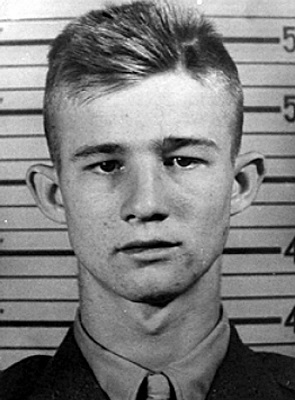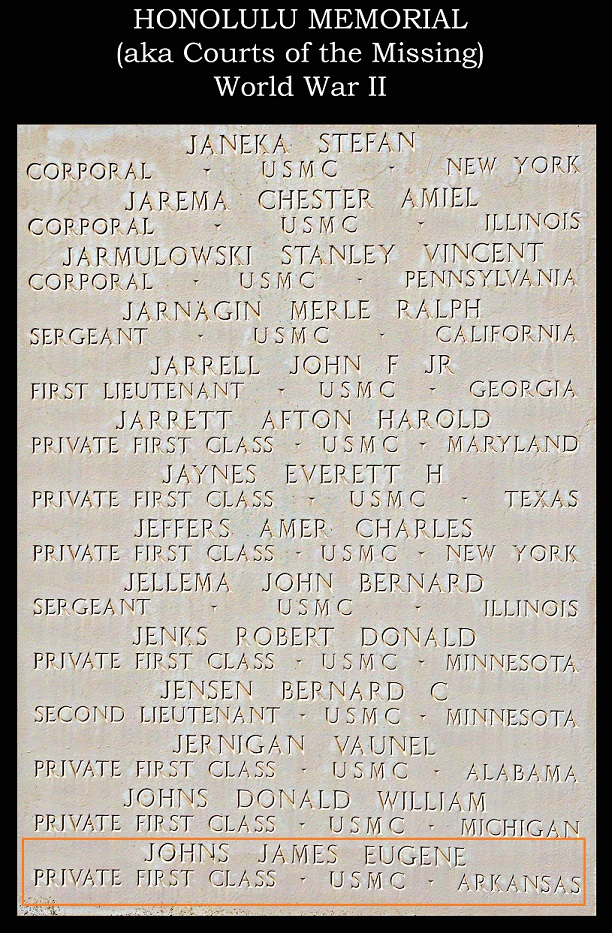James Eugene Johns
1925 - 1943


James Eugene Johns was born May 15, 1925 in Sebastian Co., Arkansas, son of
James & Ruby Jewel Holloway Johns.
James enlisted in the US Marine Corps. on 4 Nov 1942.
Pfc. Johns was attached to Co "E", 2nd Bn, 2nd Marines 2nd Marine Div, Fmf.
Pfc Johns lost his life on 20 Nov 1943 at Tarawa, Gilbert Islands, Kiribati. 18 years old.
In the Battle of Tarawa (November 20-23, 1943) during World War II (1939-45), the U.S. began its
Central Pacific Campaign against Japan by seizing the heavily fortified, Japanese-held island of
Betio in the Tarawa Atoll in the Gilbert Islands. The 18,000 U.S. Marines sent to tiny Betio were
expected to easily secure it; however, problems quickly arose. Low tides prevented some U.S.
landing crafts from clearing the coral reefs that ringed the island. Japanese coastal guns pounded
the snagged vessels and desperate Marines gave up on freeing the boats and instead waded toward
shore-hundreds of yards away- through chest-deep water amidst enemy fire. Despite heavy resistance
from the 4,500 Japanese troops dug in on Betio, the Marines finally took the island after a bloody,
76-hour battle in which both sides suffered heavy casualties.
First Day of Battle: November 20, 1943
The highly coordinated U.S. battle plan at Betio relied on the precise timing of several key
elements to succeed, but almost from the beginning there were problems. Heavy sea turbulence
slowed transfer operations of the U.S. Marines to the ship-side landing crafts. A pre-invasion
air raid was delayed, upsetting the timetable for other parts of the assault. Holding for the
air raids, support ships ready to launch massive pre-invasion bombardments lingered in position
longer than expected. They were forced to dodge increasingly accurate fire from the island where
Japanese defenders were dug in.
Compounding these problems was a lower-than-anticipated tide level around the island that morning.
Most amphtracs in the first assault wave were able to reach the beach as planned, but nearly all the larger, heavier landing crafts behind them jammed into coral reefs exposed by the shallow tide. Marines were forced to abandon their landing crafts and wade through chest-deep water amidst enemy fire. Precious gear, especially radios, became soaked and useless. Many Marines were hit in the open water, and those who made it to shore arrived exhausted or wounded, ill-equipped and unable to communicate with supporting forces.
Making matters worse, the assault path through the lagoon to the shore became congested with
disabled landing crafts and bloodied bodies, which hindered the dispatching of reinforcements.
Marines on the beach crawled forward, inch by inch, knowing that to stand or even rise slightly
made them easy targets. By the end of the first day, 5,000 Marines had landed at Betio while at
least another 1,500 had perished in the process.
For more of the story about what happened to Pfc Johns and his fellow Marines the day he lost
his life or was first reported MIA go to
THIS SITE Scroll down to where you will see the date
"20 Nov".

|
|
|
|